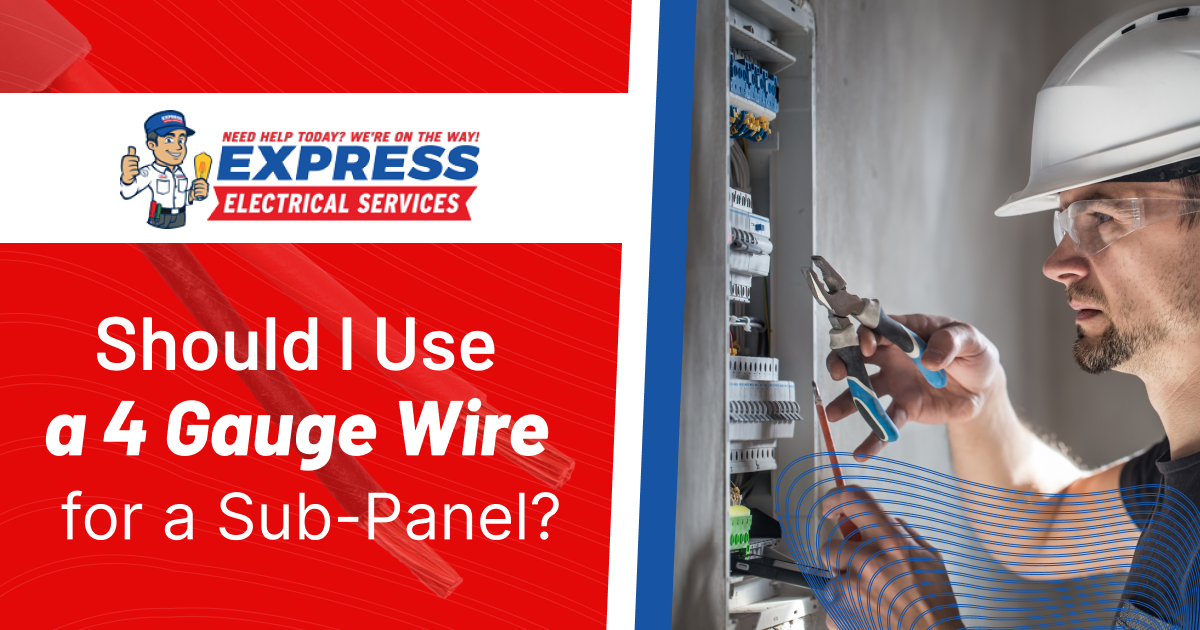Should I Use a 4 Gauge Wire for a Sub-Panel?

An electrical sub-panel may be used for a room addition or detached garage. There are lots of requirements to install one. The panel should be rated at least 100 amps and you’ll need a permit to perform the work (which generally requires an electrician). The right type of wiring must be used as well. For copper, you will need a 4-gauge wire for a sub-panel.
Wiring Requirements for Electrical Sub-Panels
The National Electric Code (NEC) requires a #4 American Wire Gauge (AWG) copper wire for sub-panels. If using an aluminum or copper-clad aluminum wire, a #2 AWG wire can be used. The minimum conduit size is 1.25 inches and a schedule 40 or 80 PVC electrical conduit is specified for lines run underground.
However, wiring requirements change depending on the sub-panel’s capacity. For example, you’ll need a:
- #3 AWG copper or #1 AWG aluminum wire for a 110-amp sub-panel
- #2 AWG copper or #1/0 AWG aluminum wire for a 125-amp sub-panel
- #1 AWG copper or #2/0 AWG aluminum wire for a 150-amp sub-panel
- #1/0 AWG copper or #3/0 AWG aluminum wire for a 175-amp sub-panel
- #2/0 AWG copper or #4/0 AWG aluminum wire for a 200-amp sub-panel
The wire connects the sub-panel to a main feeder breaker disconnect, which is connected to a 200-amp meter box. The sub-panel contains circuit breakers serving areas like a garage, home addition, or shed.
How a Sub-Panel Wire Differs from Standard Home Wiring
For any wire, the proper size is determined by the circuit’s amp rating and type of electrical installation. A #10 AWG wire may be used for a 30-amp appliance while a #8 AWG wire can accommodate a 45-amp appliance. A #14 AWG wire is typically acceptable for a circuit with general lighting and electrical receptacles.
The gauge number refers to the thickness of the wire. The smaller the gauge, the thicker the wire, and the more amperage it can support. This number is usually indicated by a label found on the wire coating or insulation.
Should I Use Copper Wire or Aluminum Wire?
Copper wire is most often used for residential sub-panels and other electrical components. It has a higher tensile strength (meaning it’s less prone to breakage) and is more conductive than aluminum. Aluminum wires tend to be less costly but are not as efficient. They can be safely used with a 100-amp sub-panel if the proper gauge is selected. Otherwise, you risk dealing with short circuits and electrical damage. But bear in mind aluminum is more prone to corrosion, so don’t let its abundance and affordability be the deciding factors.
In terms of fire safety, copper wire is preferable (for 100-amp service, you’ll need a 4-gauge wire for a sub-panel). It is less likely to expand when an electrical current runs through it and the wire can be run over greater distances. The transmission of current through a copper wire also requires less energy, so less heat is produced. Therefore, the fire risk is much lower.
How Many Wires Do I Need?
An electrician usually needs a three-wire cable to install a sub-panel. It contains three insulated conductors and a bare copper ground wire. The two hot wires in the cable will connect the feeder cable to the lugs on the sub-panel’s hot bus bars, while the neutral wire will connect to the neutral bus bar and the bare copper grounding wire will go to the grounding bus bar. At the main panel, the electrician will attach the hot feeder wires to the 240-volt circuit breaker, and snap the feeder breaker into a double slot. Individual circuit breakers can now be installed in the sub-panel.
Let an Electrician Install a 4-Gauge Wire for a Sub-Panel
Licensed electricians have the skillset to choose the right copper wire and properly install a sub-panel. This is not a DIY project and modern standards require a qualified professional to complete the installation. At Express Electrical Services, we install and repair electrical panels and sub-panels for customers in and around the Los Angeles area. For more information or to schedule service, contact us online or call (323) 204-4132.

“An electrician usually needs a three-wire cable to install a sub-panel. It contains three insulated conductors and a bare copper ground wire. ”
Nope. The ground wire must be insulated.